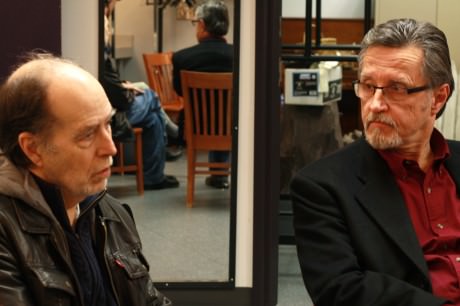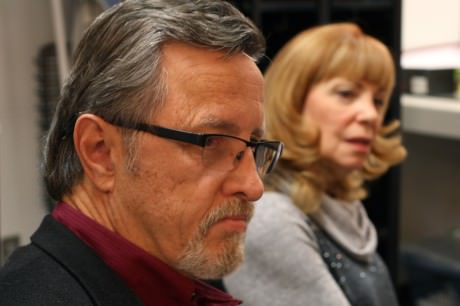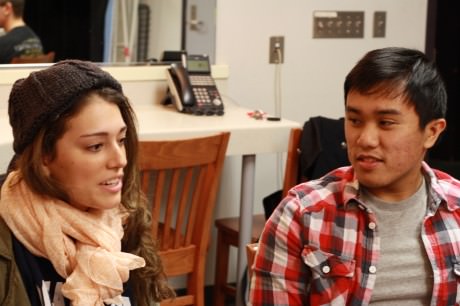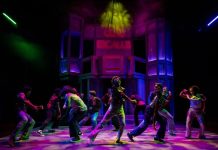In James W. Rodger’s play adaptation of the Frank Capra film, It’s a Wonderful Life, you have the confluence of many generations from little Zuzu to Uncle Billy. When doing a play that is not only a classic on both stage and screen, you can see how these generations view the subject matter and the theme of the play with different eyes.

It’s a Wonderful Life begins in the depression and then continues until the end of World War II. It traces a time in history when our national outlook went from pessimism to optimism. We had not only pulled ourselves and the world out of a depression, but saved the world from tyranny.
Some of the cast members involved in Howard Community College’s Arts Collective (AC) production of It’s a Wonderful Life were alive during the war but were very young with no personal memories. Most of their impressions of that time were created by their parents and grandparents. Others may have had grandparents who remember the depression but for the younger members of the cast, even their grandparents were too young to personally remember those experiences.
It’s also interesting to discover how this multi-generational group interacts during the course of the production. Did the older generation take on the mentoring role? Did the younger group actively seek advice? How did they view each other?
We wanted to take a peek into this interesting collection of thespians. It was decided to have two groups, one representing the older members of the cast and one the younger. To keep the either group from being influenced by the presence of the other, the interviews were kept separate.
The first group consisted of Terri Laurino who plays Ma Bailey. Terri has performed with the Arena Players and Fells Point Corner Theatre. She heard so much about HCC’s Arts Collective she decided to audition for a role in this production. Also, present were William Stanley III (Uncle Billy) locally seen in the Oldest Living Patient, Prelude to a Kiss (AC) and as George Burns to his own wife playing Gracie Allen.
Ilene Chalmers is Aunt Tilly who also appeared in AC’s production of Prelude to a Kiss and Urinetown at the Red Branch Theatre. She has a degree in theater from the University of Maryland. Gary Grabau portrays the notorious Mr. Potter. Gary, who laughingly wondered if he is being stereotyped, played J. P. Morgan in AC’s production of Ragtime:The Musical and was in Howard County Summer Theater’s production of The Will Roger’s Follies.
Rounding out the group was Bruce Leipold, as Mr. Gower, who was most recently seen in AC’s productions of The Crucible and A Funny Thing Happened on the Way to the Forum, and Kathryn Marshall, Mrs. Hatch, seen locally in AC’s production of Peter Pan and in Red Branch Theater’s production of Urinetown.

The older cast was asked how many years they have been involved in theater.
Three Howard Community College students were chosen to represent the younger section cast. Their average age, by comparison, was just over 22. They included Meghan Abdo as Violet Peterson, a recent graduate of Mount De Sales High School. She recently appeared in AC’s production of Ragtime: The Musical, and Diego Esmolo as Mr. Martini, a recent graduate of Long Reach High School who also performed in AC’s production of Ragtime: The Musical. The more experienced and slightly older member to the group at the ripe old age of 26 was Scott Lichtor as Ernie, who has been a member of the Applied Physics Lab Drama Group and recently directed 12 Angry Men for that group. Scott is employed at APL and is a part time student at HCC.
Both groups saw the benefits of working with the other. The 50 plus group used words like “adorable,” “extra exuberance,” and “energy” to describe the younger generation. The second told of a wider range of talent in their more senior counterparts. Both interestingly used the word “cool” – a word that seems to have transcended the generations. The older cast did not see themselves as mentors but the younger cast saw them in that role. Terri mentioned helping some younger actors out during auditions, but Meghan mentioned getting help developing the layers of her role from several of the older female cast members during rehearsals, including Ilene and Terri. All said the group was like family and very supportive.

Everyone in both groups had seen the movie at least once. The older group noted the play was shorter. Of course, most have them had seen the movie many times. Oddly, the film was the inspiration for Meghan to audition. Both avoided seeing it again once they were involved in this production.
All of the actors understood that their character helped in the plot development of George Bailey’s life. Bruce, for example, stated his character affected George in his youth and helped him develop honesty, and the students saw George as helping their characters develop. Diego pointed out George helped Mr. Martini live ‘The American Dream.’
All were asked what they like about their characters or did not like. Except for Mr. Potter all saw their characters as kind and “deep down sincere.” Of course by the actors’ own descriptions, Uncle Billy was a drunk, Ernie a little goofy, Mrs. Hatch a little hard on George who was marrying her daughter, and Violet very flirtatious. Meghan noted that the hardest part of portraying her character was Violet’s confidence, especially about her good looks. That may be a generational issue as women back then were possibly more likely be judged by their looks or their ability as wives and mothers in the early part of the last century.
Of course, Gary’s Mr. Potter, who is being played as unredeemable being greedy and cruel with certainty, was the farthest from the actor’s own character. Gary is a father (his daughter is on crew in this play) and described by others as kind and good natured. All saw Potter’s comeuppance, since he does not go to jail for his crime (stealing money), as being alone, as one actor stated, “What’s he doing for Christmas?”
All saw Potter as the epitome of the Scrooge-like banker and all saw comparisons in today’s world. However, both groups pointed out that George Bailey is also a banker. However, the older group felt that things were different in how people felt about bankers in a small town like Bedford Falls, the one in the story as opposed to a large city. The Depression, they felt, did not hit the small towns as hard because people were willing to help one another more directly and quickly. The younger group went so far as to state the character of Potter could represent the government. They pointed out that although George is the good guy in the play and Potter is the villain, George was also not seen as perfect.
Both groups were “Capraesque” in their points of view. Capra felt that the average man could affect change. The older group reflected how you could affect your family, friends, and community.The younger group thought more globally. Scott felt that George Bailey by being a regular person had a large impact. Interestingly, Diego thought that technology today could help get the word around. While Meghan saw the internet as both bad and good in helping others. Scott agreed. None of the seniors mentioned social media or the worldwide web. The young group saw George as a representative for the middle class, but smarter than most. Gary thought ambition was a motivator for both Potter and George. It is George’s underlying kindness and honesty that differentiates the men. Scott stated, “A lot of people are warm and sweet. You don’t have to be special to be valuable.”

The older group was more nostalgic for the lives lead by George and Mary Bailey. The values the couple represents are reminiscent of the days when stay-at-home moms were more numerous and even, compared to the stay-at-home moms today, had less activities taking them away from the home (as they were less likely to drive), for example taking kids to soccer or music classes. They thought Mary and George were more like families in small towns today. Terri missed “the wonderful moments when we all sat down to dinner.” William reminded us that families “talked to one another.” The younger group saw the play’s setting more historically when families and community were more important in people’s lives.
Naturally, the older group used their own history to understand their characters and the play. Terri’s father was in WWII, and Ilene stated, “Aunt Tillie’s sweet exuberant soul is an “homagé” to my mother.” Kathryn stated her Grandma used teabags 4-5 times and used those memories to relate to Mrs. Hatch.
William, chuckling, said he had “drunks in my family,” similar to Uncle Billy. Gary stated his father was born about the same time as George. The students, on the other hand, did most of their research from information from their History classes.

Diego had a little different background. His parents were immigrants from the Philippines and used some of their background in creating Mr. Martini. He was pleased to discover that his character may have been based on Capra’s own father, who was an Italian immigrant.
The overall impression of both groups gave is that they have learned to work cooperatively together and are very excited about this production. They all feel the play has a lesson to offer all generations. This was true if you feel at your age that, “every line memorization is a blessing,” or if you are still young enough and ambitious enough to see this chance on stage as a path to being a professional actor. Both groups seemed to be optimistic in their views which is just what you would want for the cast of It’s a Wonderful Life.
Arts Collective’s production of It’s A Wonderful Life plays from December 4-14, 2014 at Howard Community College performing at the Horowitz Center’s Smith Theatre – 10901 Little Patuxent Parkway, in Columbia, MD. For tickets call (443) 518-1500, or purchase them online.
Running Time: Approximately 2 hours, including one 15-minute intermission.
Recommended for audiences 12 years of age and up.
Here are directions to the Smith Theatre and parking information.
LINKS
Arts Collective at Howard Community College Presents ‘It’s a Wonderful Life’ December 4 – 14th by Susan G. Kramer.
Arts Collective @ HCC’s ‘It’s a Wonderful Life’ Interviews Part 1: ‘Paths Intersect Again After 20 Years’: Co-Directors Gareth Kelly and Anthony Scimonelli.





